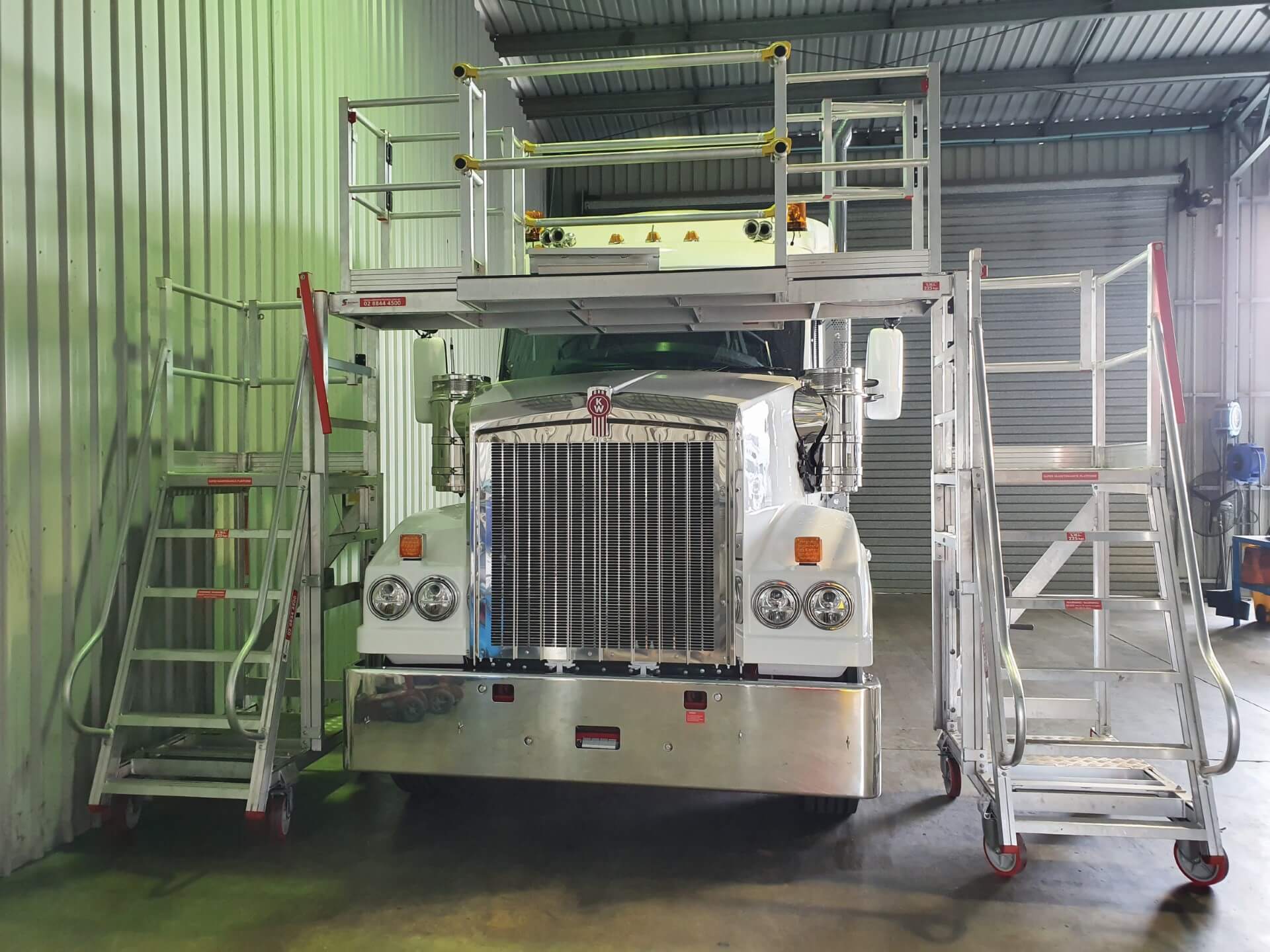


The Work Health and Safety (Managing Risk of Falls at Workplaces Code of Practice) Approval 2020 sets out a list of measures that should be taken to mitigate risks and falls when working at heights. This includes employing properly erected scaffolds or elevated work platforms that provide a stable and level surface capable of supporting workers, materials, and other loads. Additionally, ensuring that stairs are solidly constructed with fixed handrails, and that work surfaces and slopes are even and accessible, contributes to overall safety. It is also essential to maintain safe entry and exit points to minimise the risk of accidents and ensure a secure working environment. SafeSmart Access focuses on delivering a wide array of safety work platforms aimed at improving safety and efficiency for tasks performed at elevated heights. We provide a comprehensive range of platforms designed for different industries and applications, such as aviation, construction, mining, transportation, and industrial manufacturing.
These mobile/portable work platforms are engineered for effortless transportation and setup, making them ideal for use across different locations.
These fixed work platforms function as either permanent or semi-permanent solutions for working at height in specific areas.
Renowned for their versatility, these adjustable platforms offer adjustable heights to meet the specific needs of different tasks.
Custom platforms are designed to tackle the specific challenges posed by unique tasks, equipment, and environments that standard platforms may not adequately address.These platforms are designed to streamline workflows and boost productivity.
These vehicle-mounted platforms provide workers with access to elevated parts of vehicles, such as trucks, trains, and aircraft.
These cantilever platforms project out horizontally, allowing access to difficult-to-reach areas that conventional platforms may not be able to access.
The work platform is built with durable materials that can support the weight of workers, tools, and materials.
Allows for height adjustments to accommodate various tasks and ensure optimal access. This flexibility enhances functionality by providing the right working height for different applications.
Includes safe and convenient entry and exit points, such as ladders or stairs, for smooth movement on and off the platform.
Safe work platforms are equipped with effective guardrails and safety bars to prevent falls and provide additional support.
The spacious design of these platforms provides ample room for workers to move around and handle various tools and materials, boosting efficiency and reducing the time needed to transport equipment.
Work platforms feature a broader base and sturdy construction, which greatly minimises the risk of tipping or instability. This design is especially beneficial for tasks that involve standing or working at height for prolonged periods.
Meets relevant safety standards and regulations to ensure a secure working environment. Regular inspections and certifications are maintained to uphold these standards and address any potential safety issues promptly.
Ensure the platform can reach the necessary height and is equipped with safety features like guardrails, non-slip surfaces, and secure locking mechanisms. Consider whether you need a height-adjustable or elevating platform for flexibility.
Another crucial factor is the platform’s weight capacity. Ensure you know the maximum weight the platform can support, including the combined weight of workers, tools, materials, and any additional personnel. Choosing a platform with a suitable weight capacity is essential to avoid exceeding limits and ensuring safety.
For portability, choose lightweight and foldable safety platforms that are easy to transport and store, especially if you frequently move between job sites. Additionally, evaluate storage requirements and ease of movement on site to balance convenience with functionality.
Before finalising your choice, thoroughly test and inspect the platform to ensure it meets all your requirements and performs reliably. Check for any defects or issues that could affect safety and functionality.
SafeSmart Access designs platforms with a deep understanding of industry needs, especially in safety-critical sectors like mining and aviation. Our work platforms combine lightweight, durable construction with essential safety features for optimal manoeuvrability and worker protection.
SafeSmart Access platforms are designed for tough industries like aviation, mining, and construction, using durable materials like T6 6261 grade aluminium for its strength and corrosion resistance. Some of our systems feature a steel base with aluminium components for optimal strength and manoeuvrability. For detailed information on our materials and quality, we recommend reviewing product specifications or contacting us directly.
At SafeSmart Access, we specialise in custom-designed work platforms to meet your unique needs. Whether you require an adaptable aircraft docking system or a specialised platform for mining equipment, we create tailored solutions that fit your environment perfectly and enhance efficiency.
Scaffolds are used in conjunction with work platforms to offer stable and level surfaces for workers, materials, and equipment. A range of safe work practices are needed to ensure that the platforms and scaffolds supporting the workers and equipment are safe and comply with regulatory standards.
SafeSmart Access provides a range of work platforms: mobile and portable, fixed, adjustable, custom, vehicle-mounted, and cantilever. These work platforms can be used with scaffolding to provide safe access for working at height.
According to Safe Work Australia:
Under the Work Health and Safety (WHS) regulations, scaffolding is classified as a plant. This means it falls under the same type of safety obligations as other plants in the workplace, mandating employers to ensure that the scaffolding is: properly designed, tested for safety, used according to guidelines, and operated safely.
In most jurisdictions across Australia, a high-risk work license is required for anyone performing scaffolding work.
There are several qualities of a scaffold that qualify it as a work platform. Key aspects include:
Alternatively, a work platform that has been constructed from wood, metal or other materials can be placed on top of a scaffold. Essentially, the work platform acts as an elevated surface that supports workers and materials, whilst enabling them to perform tasks at a higher level.
The Occupational Safety and Health Administration (OSHA) standard for scaffolding is 29CFR1926.450. To protect workers from potential hazards, this means:
Proper scaffold must include several key safety features: